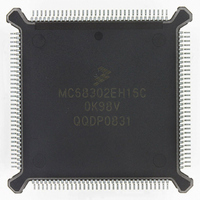MC68302EH16C Freescale Semiconductor, MC68302EH16C Datasheet - Page 374

MC68302EH16C
Manufacturer Part Number
MC68302EH16C
Description
IC MPU MULTI-PROTOCOL 132-PQFP
Manufacturer
Freescale Semiconductor
Datasheets
1.MC68302AG20C.pdf
(4 pages)
2.MC68302AG20C.pdf
(2 pages)
3.MC68302AG20C.pdf
(13 pages)
4.MC68302EH16C.pdf
(481 pages)
Specifications of MC68302EH16C
Processor Type
M683xx 32-Bit
Speed
16MHz
Voltage
5V
Mounting Type
Surface Mount
Package / Case
132-MQFP, 132-PQFP
Controller Family/series
68K
Core Size
32 Bit
Ram Memory Size
1152Byte
Cpu Speed
16MHz
No. Of Timers
3
Embedded Interface Type
SCP, TDM
Digital Ic Case Style
PQFP
Rohs Compliant
Yes
Family Name
M68000
Device Core
ColdFire
Device Core Size
32b
Frequency (max)
16MHz
Instruction Set Architecture
RISC
Supply Voltage 1 (typ)
5V
Operating Temp Range
0C to 70C
Operating Temperature Classification
Commercial
Mounting
Surface Mount
Pin Count
132
Package Type
PQFP
Lead Free Status / RoHS Status
Lead free / RoHS Compliant
Features
-
Lead Free Status / Rohs Status
RoHS Compliant part
Electrostatic Device
Available stocks
Company
Part Number
Manufacturer
Quantity
Price
Company:
Part Number:
MC68302EH16C
Manufacturer:
Freescale Semiconductor
Quantity:
135
Company:
Part Number:
MC68302EH16C
Manufacturer:
PANA
Quantity:
99
Company:
Part Number:
MC68302EH16C
Manufacturer:
Freescale Semiconductor
Quantity:
10 000
Part Number:
MC68302EH16C
Manufacturer:
FREESCALE
Quantity:
20 000
Company:
Part Number:
MC68302EH16CB1
Manufacturer:
Freescale Semiconductor
Quantity:
10 000
Company:
Part Number:
MC68302EH16CR2
Manufacturer:
Freescale Semiconductor
Quantity:
10 000
- MC68302AG20C PDF datasheet
- MC68302AG20C PDF datasheet #2
- MC68302AG20C PDF datasheet #3
- MC68302EH16C PDF datasheet #4
- Current page: 374 of 481
- Download datasheet (2Mb)
MC68302 Applications
er register (SAPR). The pointer to the destination is located in the destination address point-
er register (DAPR). The byte count register (BCR) specifies the number of bytes to be
transferred and is decremented once for each byte transferred. Note that the six SDMA
channels on the MC68302 have a higher priority than the IDMA (unless the IDMA is perform-
ing a maximum rate burst).
D.5.2 IDMA Software Initialization
Information that describes the data block to be moved, the transfer methods, and the control
options is loaded into the channel mode register (CMR). See Table D-2 for these required
selections. Loading the SAPR, DAPR, and BCR are also part of the initialization procedure.
If the functions of the DREQ, DACK, and DONE pins are required, then their corresponding
bits must be enabled in the port A control register (PACNT).
D.5.3 IDMA Bus Arbitration Signals
Whenever the IDMA wants to transfer data, it must arbitrate for the external bus. Two inter-
nal signals are used: IDMA bus request (IDBR) and IDMA bus grant (IDBG). When no ex-
ternal resource controls the bus (BGACK is negated) nor any internal resource (such as the
SCCs) requires the use of the bus, then the IDMA can be granted the bus when it asserts
(internally) IDBR. Obtaining bus mastership occurs when 1) AS and BGACK are high (ne-
gated) and 2) external BR and BG are not indicating an external master wants the bus. To
indicate that the IDMA has taken control of the bus, BGACK is asserted while BR and BG
are not asserted. The IDMA function code bits in the function code register (FCR) can be
further used to distinguish between the source and destination accesses.
D.5.4 Triggering External IDMA Transfers
The data request (DREQ) input signal should be asserted by a peripheral when it requires
service. The MC68302 responds with data acknowledge (DACK) output signal which as-
serts when the IDMA is moving data from/to the peripheral device. A third signal, DONE, in-
dicates when the last DMA transfer cycle is in progress. The bidirectional DONE signal is
asserted by the IDMA when the BCR has decremented to zero or can be asserted by the
peripheral to terminate the data transfer.
D.5.5 Performing Internally Generated IDMA Transfers
The procedure to move blocks of data from one memory space to another can be achieved
by first loading the SAPR, DAPR, BCR, and CMR. The DMA transfer sequence begins by
setting the STR bit (see Table D-2) in the CMR. The transfer stops when the BCR has dec-
remented to zero, the external DONE pin is asserted externally, or the software clears the
STR bit in the CMR. The percentage of bus usage can be controlled by the BT bits to keep
the IDMA from exceeding 12.5, 25, 50, or 75 percent of the available bus bandwidth. The
transfer can also be interrupted by the BCLR signal, which can be activated through the
SDMA channels, or by an interrupt (see 3.8.3 System Control Bits).
D-24
MC68302 USER’S MANUAL
MOTOROLA
Related parts for MC68302EH16C
Image
Part Number
Description
Manufacturer
Datasheet
Request
R
Part Number:
Description:
Manufacturer:
Freescale Semiconductor, Inc
Datasheet:

Part Number:
Description:
MC68302 Configuring the Chip Selects on the MC68302
Manufacturer:
Motorola / Freescale Semiconductor

Part Number:
Description:
MC68302 Design Concept - Expanding Interrupts on the MC68302
Manufacturer:
Motorola / Freescale Semiconductor

Part Number:
Description:
MC68302 MC68302 Adapting a WAN Controller to a LAN Environment
Manufacturer:
Motorola / Freescale Semiconductor

Part Number:
Description:
MC68302 EKB Applications - Power Measurements on the MC68302
Manufacturer:
Motorola / Freescale Semiconductor

Part Number:
Description:
MC68302 Interfacing the MC68020 to a Slave MC68302
Manufacturer:
Motorola / Freescale Semiconductor

Part Number:
Description:
MC68302 MC68302 Software Performance
Manufacturer:
Motorola / Freescale Semiconductor

Part Number:
Description:
MC68302 Evaluating EDX on the ADS302
Manufacturer:
Motorola / Freescale Semiconductor

Part Number:
Description:
MC68302 Design Advisory #1 - MC68SC302 Passive ISDN Protocol Engine
Manufacturer:
Motorola / Freescale Semiconductor

Part Number:
Description:
MC68302, MC68360, and MPC860 Characteristics and Design Notes for Crystal Feedback Oscillators
Manufacturer:
Motorola / Freescale Semiconductor
Part Number:
Description:
Mc68302 Integrated Multi-protocol Processor
Manufacturer:
Freescale Semiconductor, Inc
Datasheet:
Part Number:
Description:
Manufacturer:
Freescale Semiconductor, Inc
Datasheet:
Part Number:
Description:
Manufacturer:
Freescale Semiconductor, Inc
Datasheet:
Part Number:
Description:
Manufacturer:
Freescale Semiconductor, Inc
Datasheet:
Part Number:
Description:
Manufacturer:
Freescale Semiconductor, Inc
Datasheet:











